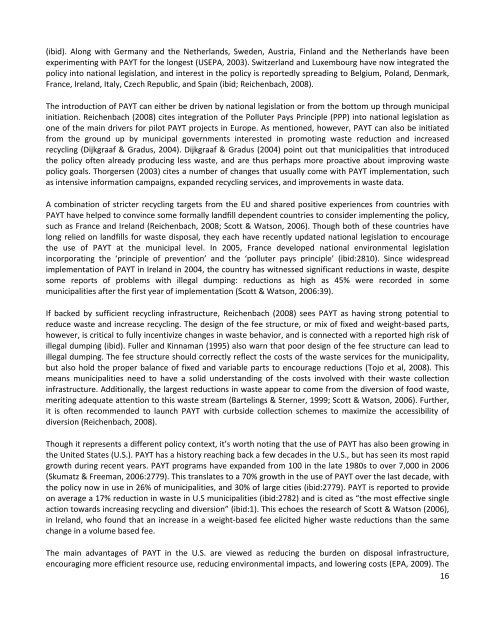Waste prevention and Pay as You Throw, a collective case ... - lumes
Waste prevention and Pay as You Throw, a collective case ... - lumes
Waste prevention and Pay as You Throw, a collective case ... - lumes
You also want an ePaper? Increase the reach of your titles
YUMPU automatically turns print PDFs into web optimized ePapers that Google loves.
(ibid). Along with Germany <strong>and</strong> the Netherl<strong>and</strong>s, Sweden, Austria, Finl<strong>and</strong> <strong>and</strong> the Netherl<strong>and</strong>s have been<br />
experimenting with PAYT for the longest (USEPA, 2003). Switzerl<strong>and</strong> <strong>and</strong> Luxembourg have now integrated the<br />
policy into national legislation, <strong>and</strong> interest in the policy is reportedly spreading to Belgium, Pol<strong>and</strong>, Denmark,<br />
France, Irel<strong>and</strong>, Italy, Czech Republic, <strong>and</strong> Spain (ibid; Reichenbach, 2008).<br />
The introduction of PAYT can either be driven by national legislation or from the bottom up through municipal<br />
initiation. Reichenbach (2008) cites integration of the Polluter <strong>Pay</strong>s Principle (PPP) into national legislation <strong>as</strong><br />
one of the main drivers for pilot PAYT projects in Europe. As mentioned, however, PAYT can also be initiated<br />
from the ground up by municipal governments interested in promoting w<strong>as</strong>te reduction <strong>and</strong> incre<strong>as</strong>ed<br />
recycling (Dijkgraaf & Gradus, 2004). Dijkgraaf & Gradus (2004) point out that municipalities that introduced<br />
the policy often already producing less w<strong>as</strong>te, <strong>and</strong> are thus perhaps more proactive about improving w<strong>as</strong>te<br />
policy goals. Thorgersen (2003) cites a number of changes that usually come with PAYT implementation, such<br />
<strong>as</strong> intensive information campaigns, exp<strong>and</strong>ed recycling services, <strong>and</strong> improvements in w<strong>as</strong>te data.<br />
A combination of stricter recycling targets from the EU <strong>and</strong> shared positive experiences from countries with<br />
PAYT have helped to convince some formally l<strong>and</strong>fill dependent countries to consider implementing the policy,<br />
such <strong>as</strong> France <strong>and</strong> Irel<strong>and</strong> (Reichenbach, 2008; Scott & Watson, 2006). Though both of these countries have<br />
long relied on l<strong>and</strong>fills for w<strong>as</strong>te disposal, they each have recently updated national legislation to encourage<br />
the use of PAYT at the municipal level. In 2005, France developed national environmental legislation<br />
incorporating the ‘principle of <strong>prevention</strong>’ <strong>and</strong> the ‘polluter pays principle’ (ibid:2810). Since widespread<br />
implementation of PAYT in Irel<strong>and</strong> in 2004, the country h<strong>as</strong> witnessed significant reductions in w<strong>as</strong>te, despite<br />
some reports of problems with illegal dumping: reductions <strong>as</strong> high <strong>as</strong> 45% were recorded in some<br />
municipalities after the first year of implementation (Scott & Watson, 2006:39).<br />
If backed by sufficient recycling infr<strong>as</strong>tructure, Reichenbach (2008) sees PAYT <strong>as</strong> having strong potential to<br />
reduce w<strong>as</strong>te <strong>and</strong> incre<strong>as</strong>e recycling. The design of the fee structure, or mix of fixed <strong>and</strong> weight‐b<strong>as</strong>ed parts,<br />
however, is critical to fully incentivize changes in w<strong>as</strong>te behavior, <strong>and</strong> is connected with a reported high risk of<br />
illegal dumping (ibid). Fuller <strong>and</strong> Kinnaman (1995) also warn that poor design of the fee structure can lead to<br />
illegal dumping. The fee structure should correctly reflect the costs of the w<strong>as</strong>te services for the municipality,<br />
but also hold the proper balance of fixed <strong>and</strong> variable parts to encourage reductions (Tojo et al, 2008). This<br />
means municipalities need to have a solid underst<strong>and</strong>ing of the costs involved with their w<strong>as</strong>te collection<br />
infr<strong>as</strong>tructure. Additionally, the largest reductions in w<strong>as</strong>te appear to come from the diversion of food w<strong>as</strong>te,<br />
meriting adequate attention to this w<strong>as</strong>te stream (Bartelings & Sterner, 1999; Scott & Watson, 2006). Further,<br />
it is often recommended to launch PAYT with curbside collection schemes to maximize the accessibility of<br />
diversion (Reichenbach, 2008).<br />
Though it represents a different policy context, it’s worth noting that the use of PAYT h<strong>as</strong> also been growing in<br />
the United States (U.S.). PAYT h<strong>as</strong> a history reaching back a few decades in the U.S., but h<strong>as</strong> seen its most rapid<br />
growth during recent years. PAYT programs have exp<strong>and</strong>ed from 100 in the late 1980s to over 7,000 in 2006<br />
(Skumatz & Freeman, 2006:2779). This translates to a 70% growth in the use of PAYT over the l<strong>as</strong>t decade, with<br />
the policy now in use in 26% of municipalities, <strong>and</strong> 30% of large cities (ibid:2779). PAYT is reported to provide<br />
on average a 17% reduction in w<strong>as</strong>te in U.S municipalities (ibid:2782) <strong>and</strong> is cited <strong>as</strong> “the most effective single<br />
action towards incre<strong>as</strong>ing recycling <strong>and</strong> diversion” (ibid:1). This echoes the research of Scott & Watson (2006),<br />
in Irel<strong>and</strong>, who found that an incre<strong>as</strong>e in a weight‐b<strong>as</strong>ed fee elicited higher w<strong>as</strong>te reductions than the same<br />
change in a volume b<strong>as</strong>ed fee.<br />
The main advantages of PAYT in the U.S. are viewed <strong>as</strong> reducing the burden on disposal infr<strong>as</strong>tructure,<br />
encouraging more efficient resource use, reducing environmental impacts, <strong>and</strong> lowering costs (EPA, 2009). The<br />
16
















